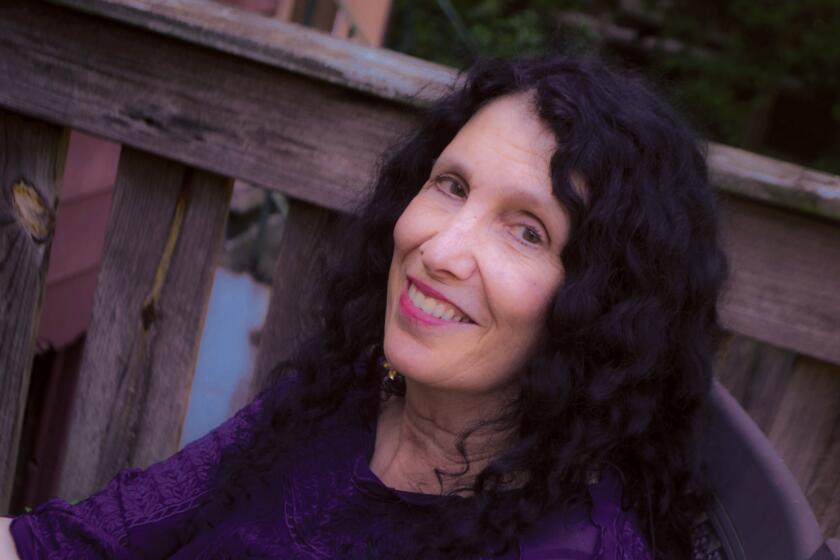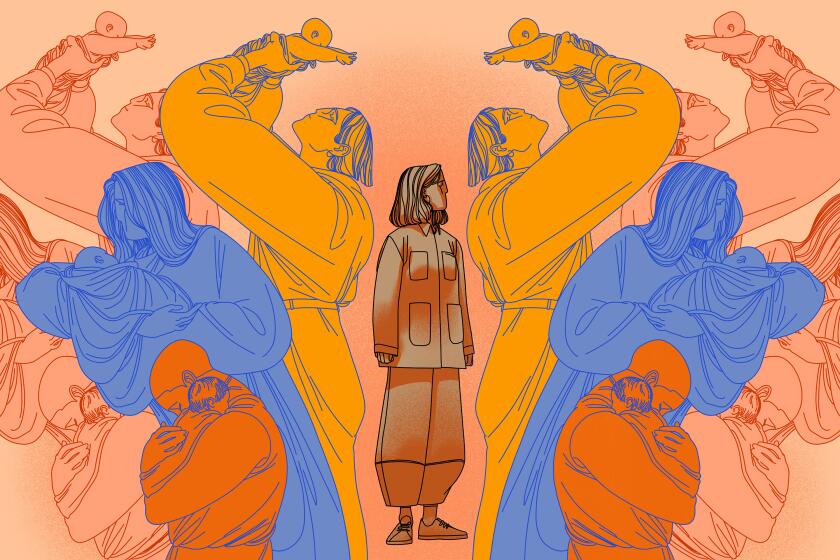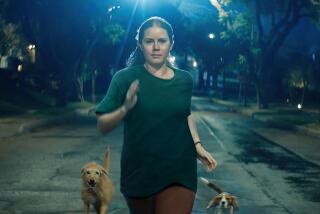What’s the secret to motherhood? How 20th century scientists got it wrong

- Share via
Book review
The Good Mother Myth: Unlearning Our Bad Ideas about How to Be a Good Mom
By Nancy Reddy
St. Martin’s Press: 256 pages, $28
If you buy books linked on our site, The Times may earn a commission from Bookshop.org, whose fees support independent bookstores.
In “The Good Mother Myth: Unlearning Our Bad Ideas About How to Be a Good Mom,” Nancy Reddy juxtaposes her own raw story of early motherhood with a tour of 20th century parenting science’s greatest hits — or worst failures, depending how you look at it.
“Before I had a baby, I was good at things,” Reddy writes in her introduction, beguilingly called “Love Is a Wondrous State,” a line she nabs from psychologist Harry Harlow. Harlow was one of the first scholars to study the “science” of motherhood in the lab. That Reddy pokes holes in Harlow’s legacy while pursuing a PhD at the University of Wisconsin, where Harlow conducted his research, is among the book’s engaging ironies.
Harlow’s most famed experiment placed infant rhesus monkeys alongside wire cylinders alternately wrapped in warmed terry cloth or barbed wire. The babies clung without fail to the “cloth mother,” “proving” to Harlow that the ideal mother was “soft, warm, and tender… with infinite patience.” Reddy had imagined herself as a cloth mother, like “all the good mothers who surrounded me in Madison,” but her new son “howled,” “roared,” “kicked,” and “flailed,” his cries “an emergency inside my entire body.” Sleepless and gripped by an identity crisis, Reddy spends her days reading Harlow’s papers: “If Harlow had discovered what made a mother good…on the same campus where I studied, I wanted to learn it, too.” What she learns instead is the power of culture to bend science to its will.
Harlow pushed what was at the time a radical stance: that breastfeeding wasn’t required for bonding. This prompted one contemporary journalist to comment that “anyone can be a mother” — presumably, even a father.
Unsurprisingly, this message never made it to the postwar American public, even as Harlow (and John Bowlby, his sometime collaborator and the originator of “attachment theory”) had their findings covered by widely read magazines. The media largely highlighted the conclusion that mothers needed to be soft and constantly available.

The scientists, too, seemed to distort the social implications of their work. In a World Health Organization-commissioned report on the state of mothers and children in the postwar era, after state-sponsored day care enabled women to enter the workforce in droves, Bowlby listed “working mother” on a list of primary dangers to children, sandwiched between “famine” and “bombs.”
As the ’50s repackaged Harlow’s findings, the campaign to keep mothers out of the workforce redesigned the lab. Reddy compares psychologists’ experimental setup that “filled cages with mother rats… each mother isolated with her offspring” — an attempt “to study motherhood in its essence” — with the world of “the ideal suburban housewife, home alone with her small children.” Bowlby and Harlow “looked at animals that suited them, and they saw what they’d expected to find” — that the unattainable ideal of motherhood meant women doing it all on our own, all the time.
Reddy aims to shine a light on how social science fed mothers the “false choice” between being everything to our babies or having other ambitions — for work, friends, anything outside domestic life. And she wants to trade that mentality for a vision to “share the work,” a version of what cultural anthropologist Margaret Mead called “alloparenting.”
That’s what the biologist Jeanne Altmann found studying baboons in the wild. The baboon mothers, through social hierarchy and grooming, formed networks of female friendships to “protect their offspring from danger and identify food sources to share.” Reflecting on an idyllic time in her childhood, Reddy describes how her newly divorced mother and newly divorced aunt shared domestic spaces and child care, their four daughters thriving in their rickety old houses, watching “The Cosby Show” and doing homework together. Until, that is, both women remarried and moved their daughters in with their new husbands. “We’d been baboons,” Reddy writes, with rueful tenderness. “Then, we were rats again.”
Leavitt’s gift for complex yet self-aware protagonists makes us root for them, even if they’re misguided.
“The Good Mother Myth” is filled with memorable one-liners like this (“Some men really will invent an entire academic discipline instead of going to therapy,” Reddy writes drolly of Bowlby). But what saves the author from being too clever or glib is her rigor in examining how often academic scholarship on motherhood relied on socially motivated foregone conclusions, pushed by men who often neglected their own families.
Reddy’s journey is also personal: Her advocacy for a collaborative motherhood is informed by her terrible loneliness, so common in America, in her first year as a mom. She captures how the occasional visits she gets from friends and family accentuate her overall isolation, and how a woman at a postpartum exercise class sees her when she feels like a drowning, invisible failure.
Like the mythical good mothers she seeks to deconstruct, Reddy is white, straight and affluent, raising her children in a two-parent household. Conspicuously absent from the book are the difficulties of mothers who do not occupy the same social position, and the roles that race and class play.
But the focus on well-to-do white people helps make Reddy’s point. Everything Reddy experiences, from the moment she unlatches her nursing bra to expose her “raw and cracked” nipples to her baby’s body contorted with unexplained screams, is an ordinary part of what in the U.S. counts as a desirable parenting situation. When Reddy tells us that she “was a bleeding, leaking mammal, weeping in the produce section” who barely survived, she’s articulating the experience of countless women across the spectrum of American motherhood. She attributes her survival to her ability to ask for, and receive, help from the community of women she had gathered around her, with a history of always having her basic needs — decent healthcare, food and housing — met. If they hadn’t been — well, what might have happened then?
‘The Lost Daughter’ shows not all women want to be mothers. I’m hungry for more of these stories.
That question reverberates when, one summer day, Reddy’s sister calls to tell her that a woman they knew growing up took her life in a state of postpartum psychosis. “I know you’ve been having a hard time,” Reddy’s sister says, crying. Reddy assures her that while it is hard, it isn’t “like that” — she is “okay,” or OK enough. The other woman, not OK, becomes Reddy’s shadow as the book propels us through her son’s first year of learning to roll over, pull himself up, walk and talk. Reddy’s feelings of invisibility are made all the more real by her doppelganger’s definitive absence.
Sometimes I wished “The Good Mother Myth” were a traditional memoir, because the personal sections are so compelling. But the narrative juxtaposition with intensive research serves a purpose. By rooting the unattainable standards that taunted her in last century’s bunk science, Reddy takes aim at the underlying power structures, including higher education and white supremacy. “The Good Mother Myth” ends with the pandemic; as the walls close in on Reddy, she writes, “I finally cracked.” A lot of us did. She resolves this by insisting that her husband share the load, a transition that she says happens — after years.
I believe Reddy, and I admire her admonition that “a man who genuinely can’t, or won’t, learn to pack a lunch … is not a man you need to stay married to.” Her book makes clear how much work we have left to do to untangle notions of goodness and prescribed labor from motherhood.
Emily Van Duyne is an associate professor of writing at Stockton University and the author of “Loving Sylvia Plath: A Reclamation.”
More to Read
A cure for the common opinion
Get thought-provoking perspectives with our weekly newsletter.
You may occasionally receive promotional content from the Los Angeles Times.












